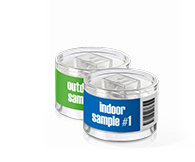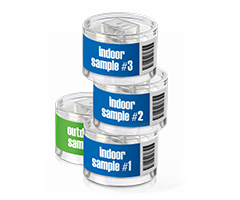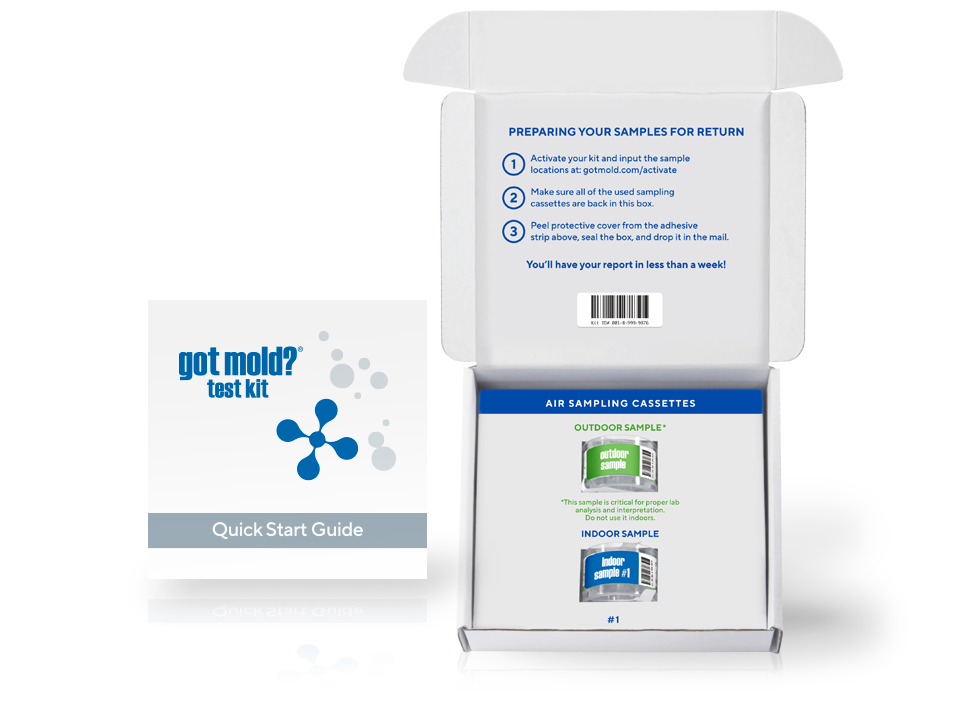In a word: Everything. We looked at every test kit out there and couldn’t find a single one to recommend. So we designed ours to overcome all of their shortcomings.
GOT MOLD? Test Kit
What’s in your air? Professional quality mold testing in 30 minutes or less. Get everything you need, with nothing else to purchase or pay for.
Get 17.76% Off! Use code SALE1776 — now through July 6th.
INCLUDES:
- All Lab Fees
- Accredited Analysis
- Easy Instructions
- Free Shipping – Both Ways!
- Reusable BioVac™ Air Sampler (batteries included!)
- Air-O-Cell® Air Sampling Cassettes
- Detailed Lab Report
- Color-Coded Interpretation
- Legendary Support
Stop wondering. Start knowing. Choose below.




GOT MOLD? Refills
Already Have a BioVac™ Air Sampler? Retest for less. Order your refills today!
Get 17.76% Off! Use code SALE1776 — now through July 6th.
INCLUDES:
- All Lab Fees
- Accredited Analysis
- Easy Instructions
- Free Shipping – Both Ways!
- Air-O-Cell® Air Sampling Cassettes
- Detailed Lab Report
- Color-Coded Interpretation
- Legendary Support
- DOES NOT INCLUDE a BioVac™ Air Sampler
Stop wondering. Start knowing. Choose below.




What People Are Saying
Doctor Recommended

As an allergist, I commonly see patients who have allergies, asthma or sinusitis. Often they will have exposure to agents in the home which can worsen their symptoms. Mold is a serious problem for many patients and can be difficult to find. The GOT MOLD? test kit provides a means of doing so which is convenient, easy to use, and relatively inexpensive. In addition to recommending it to patients, I have used it myself and been able to use the results to determine the presence of mold and to also determine where and when remediation needs to be performed. In fact, I believe that affordable mold testing is so important, that I’m also an investor. I urge anyone who has symptoms, especially if they are increasingly difficult to control, to seriously consider the GOT MOLD? test kit.
Partners



Customers
Having experienced mold in my home on multiple occasions, it was a relief to have the Got Mold’s test delivered to my door. Their at-home collection process is very thoughtfully designed, easy to use, and avoids the expense and hassle of hiring an expert to do the testing.
The instructions were crystal clear and it took me only about 20 minutes to do all of the testing for three rooms in our home. Not only that, my results were returned super speedily and I’m already taking the next steps to get rid of the mold in my basement.
My wife Ashley and I are expecting our first daughter and have been doing research on air quality. We decided to try the GOT MOLD? kit. It was surprisingly simple to use. Fortunately, our tests came back with normal levels, which gave us much needed peace of mind.
We simply watched the video instructions, followed the steps to collect samples, and dropped them in the mail. We got the results in just a few days. What a great new way to have peace of mind without spending thousands on a mold inspector.
My wife was concerned about the appearance of some black fuzz in a ceiling crack. I decided to test our house completely with the Got Mold? Test Kit. Working with your test kit is amazing, very user friendly, professional, and even fun. I felt like a scientist.
Mold Testing in 3 Simple Steps

Get Your Kit
Choose a 1, 2, or 3-room kit
Expect your kit in a few days
Prepare your home
Test Your Air
Collect air samples in minutes
Activate kit and register online
Return samples for analysis
Get Your Results
Receive automated status updates
Get results in less than a week
Plan next steps with confidence
What Makes Our Mold Test Kits Different?
Free Shipping
No Surprise Fees
Fast Turnaround
Easy-to-Use
No Paperwork
Easy-to-Read
Accredited Analysis
Batteries Included
Simple Pricing
No Conflicts of Interest
Eco-Friendly Packaging
Assembled in USA
FAQs
The GOT MOLD? Test Kit tests your air with spore traps, the most widely utilized method of professional air sampling for mold. It’s why we often say that you’ll be testing “like a pro!”
The Air-O-Cell® air sampling cassettes included in the GOT MOLD? Test Kit are known as spore traps. They act as filters, collecting spores and other microscopic particles pulled through them by the reusable BioVac™ Air Sampler.
Cassettes are analyzed by a microbiologist employing direct microscopic investigation to count and classify the different spores present in each sample.
Spores are identified using up to 245 different categories — mostly genus level and higher — covering ALL KNOWN spore-producing molds and fungi (roughly 100k species).
Our software takes the lab’s analysis and determines if there are unusual types and/or quantities of indoor mold present. These determinations (along with spore counts) are displayed on your final report as:
Green = not evident
Yellow = slight evidence
Orange = moderate evidence
Red = significant evidence
You won’t need an expert to interpret our report. You’ll receive clear, concise results in an easy-to-understand format, along with the raw laboratory data, which could prove useful in the event your situation requires professional help. In that case, your inspector or home professional may have all the necessary information to proceed without having to repeat testing.
Our reports are color-coded Green, Yellow, Orange and Red, with a simple explanation for each color.
Green indicates your indoor air samples are similar to your outdoor reference sample and that no evidence of indoor mold growth was detected.
Yellow is an Alert Condition and indicates we found slight evidence of indoor mold growth. You may want to consider further investigation.
Orange indicates we found moderate evidence of indoor mold growth. This is a more elevated Alert Condition and strongly suggests you should consider further investigation by a professional.
Red is our highest Alert Condition and indicates we found evidence of significant indoor mold growth. In this instance, we urgently recommend you consult a mold assessment professional and take immediate actions to minimize exposure.
In all cases, regardless of the readings, if you or anyone else is experiencing symptoms that you believe are mold-related, we recommend seeking medical advice.
Pre-Testing Prep
- Keep windows and doors closed as much as possible 2-3 days before testing.
- Turn off all stand-alone air filters and purifiers 2-3 days before testing.
- If your space is currently or has recently undergone renovation, be sure debris is cleared out.
Day of Testing:
- For best results, choose a day when it’s not raining or snowing.
- Do NOT turn off heating and/or AC systems. Air needs to be moving around the room to get an accurate reading.
- Do NOT mow grass, rake leaves, or otherwise disturb the property.
Pump Placement:
- Use a clean surface at least 30” off the ground. (Same for the Outside sample.)
- Choose a spot close to the center of the room.
- If the area being tested is more than 500 square feet or separated by walls, consider using more than one sampling cassette. (General rule of thumb is to use an additional cassette for every 500 square feet.)
Generally speaking, one cassette will cover one room. So if you are testing two normal-sized rooms, two cassettes will do the trick. Three rooms, three cassettes, and so on.
If, however, a room is quite large, e.g., a big basement of approximately 2000 square feet or more, then two cassettes — possibly even three (left, middle and right) — are required for accurate results.
For bathrooms or any other small room that has a door or is set apart from a normal-sized room, e.g., the master bathroom, use an individual cassette.
As an overall example, if you would like to test three bedrooms, one bathroom, and one closet, we recommend using five (5) cassettes.
Refills can be purchased here.
Mold is a normal part of our environment, as mold spores are present in the air practically everywhere. These spores differ widely in type and quantity, from place to place. Even in a building that doesn’t have a mold problem, there are still mold spores in the air, arriving from the outside through doors and windows, cracks and crevices, or tracked in by people and pets. This is known as infiltration.
The green cassette provides a sample of the environment outside of your home, giving the lab a baseline from which to analyze your indoor samples.
No. Mold is everywhere in our natural environment, meaning every location is unique and will have different molds and different quantities.
The Outdoor Sample, which is essential for determining the relative health of your indoor air, needs to be taken within close proximity of the Indoor Sample(s). It does you no good to take the Outdoor Sample in front of your house and then test a room on a different property, even if the properties are relatively close. For that, you would need to purchase a refill, which includes a fresh outdoor cassette and up to three indoor cassettes. (The good news is the pumps are reusable, so there’s no need to buy a second full kit.)
Even when testing a guest house or some other ancillary building on the same property, we generally suggest using a fresh Outdoor Sample.*
*If you decide to use the same Outdoor Sample for more than one building on the same property (again, not recommended), it’s vital you stick to what we call the Principle of One: one kit, one property, all within one hour.
Once the lab receives your samples, the results will be available in three business days.
Once your report is ready, the results will be immediately available online at gotmold.com. You will be notified by text (SMS) and/or email, based on what you selected as your preferred delivery method(s) during kit activation.
Remember, every home and building has mold, but not every home and building has a mold problem.
The first step is to determine the exact cause of the moisture. After all, a mold problem is really a moisture problem. The next step is to determine the extent of the repairs and cleanup.
If these steps are beyond your ability, we encourage you to find an independent and qualified mold assessment professional in your area. That professional should perform a thorough physical inspection (additional testing may be needed) and provide a comprehensive written report with specific observations, detailed recommendations and, if necessary, a remediation plan.
Finding a mold inspection professional who is not also a remediator can be a challenge, but it’s important that you do. Mold inspectors should never be remediators, especially on the same project. This presents a serious conflict of interest, so much so that having an inspector double as a remediator is outlawed in several states.
Occasionally, a report from the lab is delivered to the customer with incomplete results. And in rare cases, the lab is unable to generate a report at all. In these scenarios, one or more of the sampling cassettes were compromised, missing or did not register any data.
These are the terms that you may see for an incomplete or ungenerated report:
Overloaded – Cassette contained excessive background matter (heavy dirt, dust, debris, etc.)
Defective – Cassette was defective
Blank – Empty, unused cassette
Missing – The lab did not receive a cassette
For complete definitions and next steps, click on the link below:
You can, but it’s not recommended. With doors and windows opening and closing regularly, the inside of your car has a far less consistent environment than the inside of your home.
We recommend instead that you use your nose: If the inside of your car has a musty smell, you likely have mold and do not need the test.
If you do decide to sample the inside of your car, we recommend:
- Keeping the doors and windows closed for 2-3 days prior to testing.
- Having your A/C on during testing, since mold growth can occur behind the vents.
- Performing the test where the car is normally parked.
The GOT MOLD? Test Kit is not designed to be a replacement for a mold inspection performed by a qualified professional. Its purpose is to be a cost-effective first step. You might compare it to an at-home pregnancy test kit: you wouldn’t immediately start buying baby furniture if it came back positive, right? Please use the same common sense here. You should not make major life decisions, such as planning remediation, filing lawsuits, relocating, etc., based solely upon the results from this — or any — DIY mold test kit.
If there are Alert Conditions detected using this kit, and you intend to take action, we recommend you find a qualified mold assessment professional to perform a thorough physical inspection (additional testing may be needed) and provide a comprehensive written report with specific observations, detailed recommendations and, if necessary, a remediation plan.
Our test kit includes the reusable BioVac™ Air Sampler, using spore traps that collect the microscopic particles floating around in the air in the immediate area being sampled — at the time of sampling. These conditions can differ minute-to-minute, depending upon many factors, such as ventilation and movement in the building. Since air is a constantly changing landscape, the results from this kit are not to be considered a measure of exposure or risk, and shouldn’t be used to determine whether a building is “safe.”
Also, since spore traps capture spores in the air, if there’s a hidden mold problem in a wall, for instance, this method may not detect it. Similarly, if the air in the room has been still for quite some time, spores may have settled out of the air, which may produce misleading results.
You must carefully follow the instructions in the Quick Start Guide. Not doing so may lead to inaccurate results.
In all cases, if you are experiencing health issues that you believe are building-related, please seek medical advice.
Have more questions? Want to do more research?
Go to our extensive Learning Center and find out what the experts have to say.















